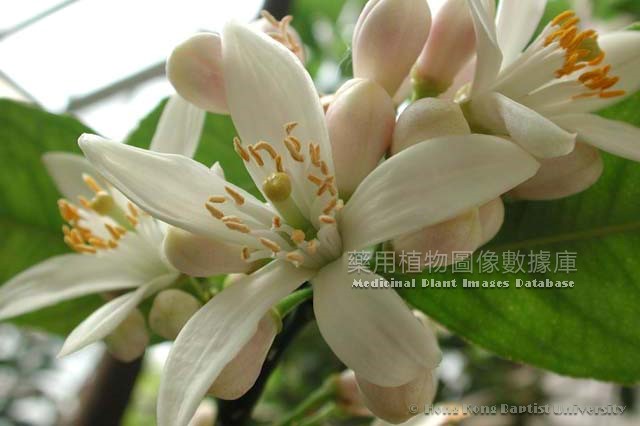|
Citrus aurantium L. var. amara Engl.

|
English Name |
Daidaihua, Daidai, Seville |
|
Latin name |
Citrus aurantium L. var. amara Engl. |
|
Family & Genus |
Rutaceae, Citrus |
|
Description |
Evergreen small trees, 5-10m tall. Branches with sparse short thorns, twigs with angles. Leaves alternate, elliptic to oval-elliptic, 5-10cm long, 2.5-5cm wide, apex acuminate, blunt end, base broad cuneate, margin with wavy teeth; leaf wings inverted heart-shaped; coriaceous, with translucent oily dots. Flowers solitary or racemes clustered in leaf axils; calyx cup-shaped, 5 lobed, lobes ovate, with tricholoma; flowers white, petals 5, long oblong, 2-2.5cm long; stamens 21-24, often 3-5 pieces combined at the base of filaments; ovary of pistil superior, oblate, style cylindrical, stigma head-like. Hesperidiums oblate, 7-8cm in diameter, not aromatic, fruit top with shallow radicalized grooves, fruit calyx thickened, fleshy, peel orange red, slightly rough, oil cells large, uneven; pulp capsule about 10. Seeds elliptic, apex cuneate. Flowering: May to June, fruiting in December. |
|
Distribution |
Growing on hilly areas or hills. Can be cultivated. Distributed in the southern parts of China, Zhejiang, Jiangsu, Guangdong, Guizhou and etc. The medicinal materials are mainly produced in Zhejiang, Jiangsu and etc. |
|
Part Used |
Medical part: buds. Chinese name: Daidaihua. |
|
Harvest & Processing |
Picked buds when flowers have not bloom from May to June in batches and dried timely. |
|
Chemistry |
Contains volatile oils, such as limonene, linalool, and flavonoid, such as neohesperidin and naringin. |
|
Properties & Actions |
Sweet, little bitter, neutral.Regulating qi-flowing for loosening the chest and stimulating appetite. |
|
Indications & Usage |
Used for thoracic and abdominal distress, accumulation of food in the stomach and intestine due to indigestion, phlegm and retained fluid, anal prolapse.Oral administration: 1.5-2.5g, decocting, or prepared tea. |
|
Examples |
1. Abdominal distention: seville orange flower, rose, officinal magnolia flower 3g each, decoct in water and swallow.
2. Gastric pain: seville orange flower 3g, prepared nutgrass galingale, szechwan chinaberry fruit, white peony root 9g each, decoct in water and swallow, one time a day. |
| Link to |
 Chinese Medicinal Material Images Database Chinese Medicinal Material Images Database
 Phytochemical Image Database Phytochemical Image Database
 Chinese Medicine Specimen Database Chinese Medicine Specimen Database
|
|

